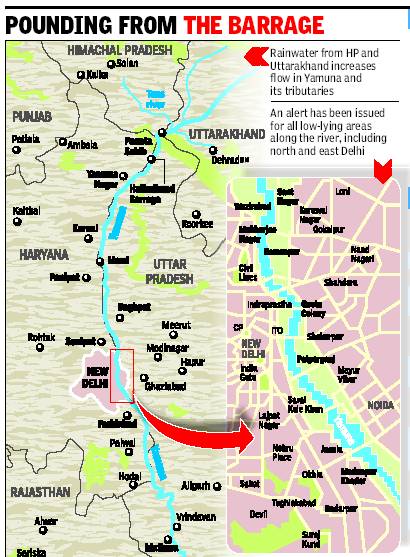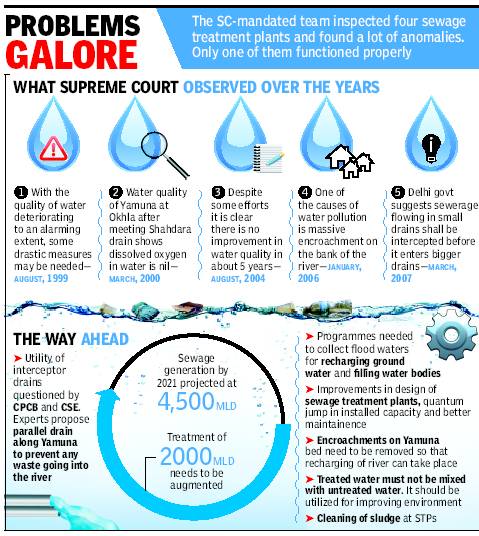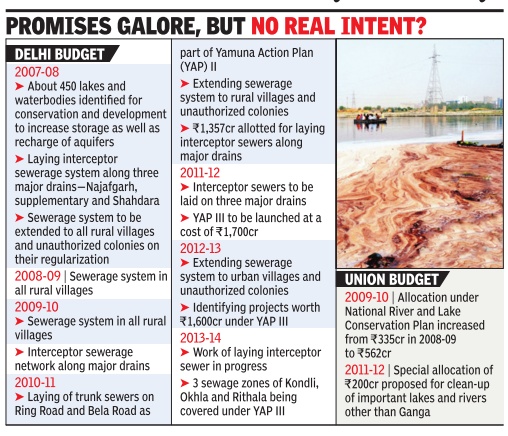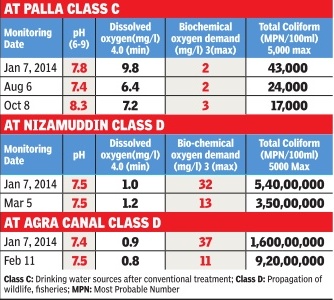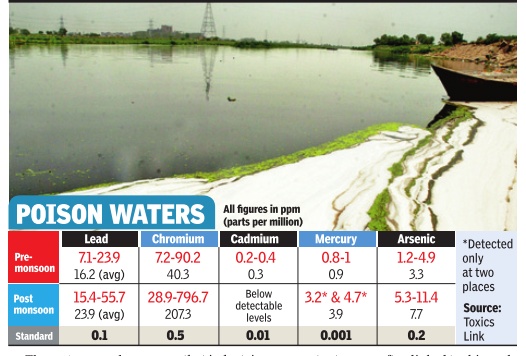River Yamuna
This is a collection of newspaper articles selected for the excellence of their content. |
Contents |
Riverfront planning: 1913-2000
Feb 11 2015
Jayashree Nandi
Riverfront planners caught in time warp
Govt trying to urbanize Yamuna since 1913: Scientists
Delhi had planned for a riverfront for Yamuna as early as 1913 to give the new capital an aesthetic promenade from Wazirabad in the north to Indrapat (Purana Qila and its surroundings) in the south.Hundred years on, the central government continues to idealize urban riverfronts like that of the Sabarmati and has been floating proposals to make Yamuna an urban infrastructure component such as dredging it to make it navigable. Awadhendra Sharan, associate professor at Centre for the Study of Developing Societies, whose research paper on Yamuna was published in Elsevier's journal of City , Culture and Society, traces how various authorities at different times in history tried to develop the river and the riverfront.
Around 1956, the Town Planning Organization suggested development of a riverfront for recreational activities with playgrounds, swimming pools, and fishing and bathing areas. “It drew attention to the possibility of taming the river by building a dam,“ writes Sharan.
Cultivation of melons on the banks in summer and fishing were common in Okhla. Floods were an annual phenomenon but there was ample land for free flow of river during the monsoon months. A new phase of urbanizing the river began after Independence in 1955-56 leading to floods becoming a health issue with w aste water discharge points near the river affecting quality of drinking water. In 1990, DDA too planned several urban projects to integrate the city and river.
Over the past two decades, Yamuna became extremely polluted and ceased to be a peren nial river. This is when the gov ernment started blaming squatters in illegal colonies along Yamuna for the pollution and began pushing “technologi cal solutions“. One of the major changes in approach is marked by the high court nod to the Com monwealth Games Village. Sha ran recollects in his paper how there were discrepancies in var ious technical reports submit ted to the court on the impact of Games Village which led to the court deciding that the area for it was not on the floodplains.
Another high court decision in March 2003 led to removal of the Yamuna Pushta slum clus ter. But various studies and ex perts say this will not help ad dress pollution.Sharan suggests the “precautionary principle“ should have been applied before such irreversible changes--like building Akshardham and the Games Village--were made. “I have tried to argue from all the historical evidence that's availa ble that we should leave the river as it is and not convert it into a re al estate operation. That makes more economic and ecological sense,“ Sharan says.
Yamuna: The state of the river/ Pollution
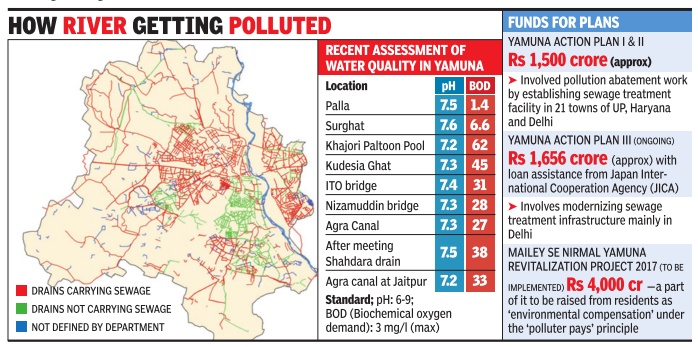
6,500cr and 19yrs later, Yamuna dirtier than ever/ Clean-Up Plan Flops, SC Review today
By Neha Lalchandani 2013/03/11
[In 1994?] the Supreme Court first scrutinized pollution in the Yamuna. Innumerable orders later, Yamuna is dirtier than ever with a mind-numbing Rs 6,500 crore spent to clean the river and the latest plan — interceptor sewers — going
When SC reviews Yamuna’s pollution, it could be back to the drawing board. Six years after the Delhi Jal Board proposed interceptor sewers to treat sewage before it flows into major drains, just Rs 51 crore of the Rs 1,963 crore scheme has been spent.
Worse, it is not even clear if the measure that was to improve water quality by 2010 will actually work in light of the rapid growth of unauthorized colonies discharging sewage into the river, an issue flagged even in 2007 by an official committee that approved the interceptor proposal.
The committee had warned that 1,432 unauthorized colonies were the nub of the problem. By 2012, their number had jumped to 1,639. Although these colonies have been promised regularization, drainage and sewers are years away. In 2007, 517 of 567 unauthorized regularized colonies had sewers. The number grew by just six in the next five years. DJB says it is tough to provide sewerage in such densely populated colonies where they have barely any road space for their work.
A report submitted to the court by an inspection team that included amicus curiae Ranjit Kumar as recently as November last year called for sewage connections to all new colonies, whether authorized or not.
It pointed out that Delhi’s 17 sewage treatment plants (STPs) have a capacity of 2,460 MGD against utilization of 1,558 MGD. Delhi’s sewage generation is around 3,800 MGD.
Throwing money in the river
6,500cr spent by Delhi, UP and Haryana to clean Yamuna. This includes central funds. No improvement in water quality in past 8 yrs Only 51cr of 1,963cr sanctioned for interceptor drains spent. Scheme proposed in 2007, was to deliver results by 2010 Number of unauthorized colonies has jumped from 1,432 in 2007 to 1,639 in 2012
Only 55% of Delhi’s population served by sewer system
Delhi’s installed sewage treatment capacity is 2,460 MLD. Sewage generated is 3,800 MLD. But just 63% of installed capacity is being used
City’s biggest drain, Najafgarh, discharges 2,064 MLD. Only 30% is treated.
Worse, treated sewage is again mixed with waste
SC-mandated team inspected 4 sewage treatment plants in November 2012.
All four were deficient
Heavy metals in city’s drinking water
Delhi’s drinking water is contaminated with tonnes of industrial waste. Industries located upstream of the Yamuna have been found to be discharging untreated waste into the river, leading to the presence of heavy metals in water that is picked up at Wazirabad to meet the city’s drinking water needs.
Manoj Misra of the Yamuna Jiye Abhiyan had water from the Dhanura Escape — a channel that empties into the Yamuna — tested at a laboratory in Gwalior and found that the levels of chromium, lead and iron were higher than permissible. “While chromium was 0.13 mg/l against 0.05 mg/l, lead was 0.035 mg/l against 0.01mg/l and iron was 3.51mg/l against a permissible 0.1 mg/l. The presence of heavy metals is even more problematic since the treatment plants in Delhi are not equipped to detect or treat them,” said Misra.
Pollution from industries in Haryana, especially those located in and around Panipat and Sonepat, has caused treatment plants to stop functioning on several occasions after ammonia level went so high that it could not be treated. Untreated industrial effluent from Yamuna Nagar, Misra said, is released into the Dhanura Escape from where it meets the river upstream of Kunjpura in the Karnal district.
“Similarly, toxic waste from Panipat falls into the Yamuna near the village of Simla Gujran in Panipat district. Samples from the Dhanura Escape show presence of heavy metals, known health hazards and a clear indication of industrial pollution. This water is picked up at Wazirabad for treatment at Chandrawal and Wazirabad treatment plants,” he said.
Other than heavy metals, other pollutants, too, were much higher than BIS norms for drinking water. Total coliform was 1,200 against the permissible limit of 10, total dissolved solids were 3,324 against the permissible limit of 500, biochemical oxygen demand was 240 mg/l against a limit of 30 mg/l, and chemical oxygen demand was 768 mg/l against a limit of 250 mg/l, Misra added.
Central Pollution Control Board officials said they had made it compulsory for all industries to have effluent treatment plants. “Most industries have installed ETPs but either the treatment is not up to mark or not all effluent is reaching the ETPs. We have set up a real time water pollution monitoring station at Wazirabad where we monitor 10 parameters... heavy metals are not monitored as they cannot be treated in the plants,” said an official.
The wish list
Haryana government release more water from Hathnikund Barrage for Uttar Pradesh
Alternate arrangement be made for disposal of untreated sewage in Delhi, which is at present dumped into the river at 22 places
The holy river be given due respect
The water has not improved despite generous funds
WATER QUALITY WORSE - Funds flow, Yamuna stays filthy
Jayashree.Nandi@timesgroup.com New Delhi
The Times of India Jul 15 2014
Every year the state and union budgets raise hopes that the Yamuna may after all soon get a new lease of life. In fact, the Delhi government's budget has been making the exact same promise for seven years (2008-14). Providing sewerage in urban villages and unauthorized colonies and laying interceptor sewers along major drains is its solution for Yamuna's pollution crisis. It has allotted over Rs 3,500 crore for these projects--mostly under the Yamuna Action Plans--to complete the work and ensure “discharge of pollutants comes down considerably“.
But 2014 Yamuna water sample investigations by Central Pollution Control Board (CPCB) show levels have not improved; they are worse at some sites. Delhi Pollution Control Committee (DPCC) officials also confirmed to TOI that water quality parameters including biological oxygen demand (BOD) and total coliform levels have only deteriorated or are the same in almost all monitoring sites.
Interestingly , Delhi Jal Board (DJB) claims that 68% of the work of laying the interceptor sewer--large sewer lines that control the flow of sewage to a treatment plant--is already done. The project is divided into packages, out of which two will be completed by the end of 2014 and the rest by 2015. It also claims that of 2,574 urban and rural villages, unauthorized colonies and other un-sewered colonies, sewerage was provided in 842.
But no one seems to be sure why water quality hasn't started improving. One of the reasons, say officials, is that these projects will work only when sewage treatment plants func tion to their full capacity. As of now, most STPs are functioning at 50% capacity .
The funds allocated by the union government are also difficult to track. “The union government for instance allocated Rs 562 crore for rivers in 2009 and Rs 200 crore in 2011 for lakes and rivers and Rs 100 crore for “ghat development and beautification“ for seven river side cities including Delhi this time.
Pollution in Yamuna
Increasing pollution in Yamuna
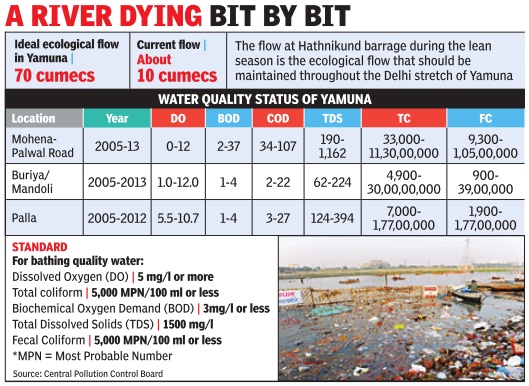
After 21 years of SC monitoring, Yamuna still stinks like a sewer
The Times of India, Jan 09 2015
Amit Anand Choudhary & Dhananjay Mahapatra
4 Lakh To 16 Crore Coliform In River Against Norm Of 5,000, CPCB Tells SC
Central Pollution Control Board told the Supreme Court why the Yamuna in its 22-km course through Delhi mostly stinks like a sewer drain as against the norm of 5,000 MPN coliform per 100 ml of water, Yamuna water in Delhi had between 4 lakh to 16 crore coliform per 100 ml. The norm of 5,000 MPN100 ml of water is the quality prescribed for `C' category of water, which is fit for drinking after treatment.But, on January 7, 2014, the total coliform in Yamuna water at Nizamuddin was 54000000 (5.4 crore) and at Kalindi Kunj it was 160000000 (16 crore). But, at Palla the river water is relatively clean. On January 7 last year the total coliform detected at Palla was 43,000.
After 21 years of intense monitoring of government efforts by the Supreme Court to clean the Yamuna, the CPCB, through advocate Vijay Panjwani, submitted to the court a detailed report on the state of pollution of river water at Pal la, Nizamuddin, Kalindi Kunj, Okhla and Madanpur Khadar in the 22-km stretch it flows through Delhi.
Despite the SC monitoring, Delhi appeared to be the biggest culprit in polluting the river. The water quality of Yamuna at Palla when it enters Delhi met the standard of “A“ grade water, which is fit for drinking without conventional treatment but after disinfection, in respect of pH level, dissolved oxygen, bio-chemical oxygen demand as well as coliform on most days except on five of the 12 testing days between November 19, 2013 and October 8, 2014.
But at the rest of the places through the city , the water did not even qualify to the standard of “C“ grade water and was declared unfit for even bathing. The CPCB also submitted the quality of water in 22 drains that joins Yamuna during its course through Delhi.
A year ago in December 2013, the Supreme Court had sought expert help from the Indian Institute of Technology (IIT) after being told by CPCB that despite Rs 5,000 crore spent for reducing pollution, the river was staring at a catastrophe as over 2,400 million litres of untreated sewage flows into it every day.
Since 1994, when the apex court took up monitoring of steps to reduce pollution in Yamuna, Uttar Pradesh has spent Rs 2,052 crore, Delhi government and its civic bodies Rs 2,387 crore and Haryana Rs 549 crore to clean the river, taking the total to Rs 4,988 crore.
A joint report by CPCB and DJB had informed the court a year ago that the situation would get worse as “waste water generation due to growth of urban population will be substantial and may be in the range of about 5,000 to 6,000 MLD respectively for the corresponding years 2021 and 2031“.
Rain not washing away toxins
Rain not washing away Yamuna toxins Jayashree Nandi The Times of India Dec 01 2014
New Delhi
Yamuna water is toxic, to say the least. But what is worse is that there seems to be a continuous discharge of industrial effluents into the Delhi stretches of Yamuna so that there is no improvement in postmonsoon months either when pollution is supposed to be far more diluted.
A recently concluded study by Toxics Link, an environmental NGO, found heavy metals like lead, chromium, arsenic and mercury to be several times the safe standard and, in some cases, even several hundred times the bathing water quality standard set by Central Pollution Control Board in preand post-monsoon months.
A team of researchers collected water samples from seven locations starting with Jagatpur village where the water appears to be marginally cleaner. The researchers travelled by boat to be able to collect water in bottles and buckets from near Najafgarh drain, Wazirabad, Majnu Ka Tila, near Vidhan Sabha drain, ISBT and Yamuna Bazar. The water samples were analysed for the most toxic heavy metals. Chromium levels were the highest with a maximum concentration of about 796.99 parts per million when the standard is 0.5ppm. The maximum level for lead was 55.7ppm when the standard is 0.1ppm.
“We couldn't find a uniform trend in preand postmonsoon levels which show that industries are constantly discharging these heavy metals leading to high toxicity levels throughout. We are also assessing whether the high chromium levels are due to tanneries discharging untreated effluents. But it's clear that a lot of industrial waste is polluting Yamuna,“ said Prashant Rajankar, programme coordinator, Toxics Link. High chromium levels are often linked to skin rashes, ulcers, weakening of the immune system, kidney and liver damage and many other health impacts.
The study was also used as an introduction for the recently concluded India Rivers Week where about 125 academics, scientists, activists from all states thrashed out the definition of a “healthy river“ and what is ailing Indian rivers. The reason for organizing such a conference is also the current government's agenda of interlinking rivers.
The 125 experts will work in four groups to arrive at a consensus on certain crucial issues related to rivers and controversial or `environmentally unsound' projects like interlinking or rivers, massive hydropower projects, dams and others. At the end of four days, experts will prepare an India rivers charter articulating the vision for saving rivers.
At IRW, experts also drew attention to a recent appraisal by Yamuna Jiye Abhiyan that has found there is no river in any of the top 50 cities (based on population) in India that is not sick or dying with river Yamuna in DelhiMathura-Agra and Ganga in Kanpur-Varanasi-Patna leading the list.
Pollution is irreversible
The Times of India, Feb 08 2015
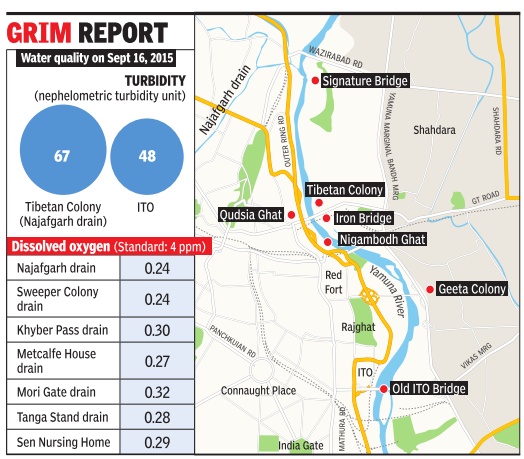
Yamuna pollution can't be reversed: Water commission
Arvind Chauhan
The Yamuna, by the time it flows through Agra, has nearly 50 times more biochemical oxygen demand (BOD) than the permissible limit. The Central Water Commission (CWC) has declared that the river water at Agra is safe neither for irrigation nor for domestic use.Water in the river, now polluted beyond repair, an official said, is also contaminating ground water.
BOD is the amount of dissolved oxygen needed by aerobic biological organisms to break down orga nic material, in a given time and at a certain temperature. Once BOD increases beyond a certain limit, it becomes a pollutant, leading to the growth of harmful bacteria.
BOD forms when the equilibrium of chemical compounds and solid waste is disturbed in a water body .
A CWC official said, “This contamination level is irreversible. Water is unusable, both for irrigation and drinking. In fact, polluted water from the Yamuna is also partially responsible for the contamination of ground water in Agra.
Floods in Yamuna
The Yamuna: The highest flood levels recorded
The Yamuna, which has been reduced to being just a drain, transforms during the rains into a raging, menacing river
1978 | 5 Sept 207.49m
The Yamuna touched 207.49m on September 5 after 7 lakh cusec water was released upstream. Large parts of west, north and east Delhi, including Shalimar Bagh, Model Town and Mukherjee Nagar, were under 4-5 feet of water. It remains Delhi’s worst flood to date
1988 | 21 Sept 206.92 m
Continuous torrential rain in the hills from September 21 raised the Yamuna’s level to 206.92m at the Old Railway Bridge. Many areas in east and north Delhi, including Mukherjee Nagar, Geeta Colony, Yamuna Bazaar and Red Fort were affected
1995 | Sept 206.93 m
In Sept, river touched 206.93m. While release from Tajewala was massive, Delhi didn't let out water from Okhla barrage fast enough. Around 15,000 families lived in temporary shelters on main road for two months
2010 | Sept 207.11 m
Towards the end of September, the Yamuna rose to 207.11m and stayed at that level for eight hours. Areas like Kashmere Gate, Batla House, parts of Ring Road, Jaitpur and Majnu Ka Tila were flooded. Back flow from sewers submerged hundreds of houses in low areas
Do floods help the Yamuna?
2013/06/22
Swell in Yamuna kills the stink
If you thought the Delhi stretch of Yamuna had long become a sewage pool, visit the river now. Flooded to the brim, it is reminiscent of what Yamuna may have originally looked like. The flood may have played havoc by displacing communities but it has also managed to dilute the polluted water and enliven a dead river.
Towards Okhla (downstream) the river water usually has a biochemical oxygen demand of 40 to 50 mg/l but since June 15, the BOD measured less than10 mg/l according to Central Pollution Control Board.
BOD is an important determinant to show how polluted the river water is. It is a measure of the quantity of oxygen used by microorganisms in the oxidation of organic matter. The acceptable limit of BOD is 3 mg/l.
“The pollutants have been washed away but the water is very turbid because of the debris that has come with the floodwater and runoff from agricultural fields. Even after the water level recedes, there will still be surplus water and we expect that pollution levels will be low for about two months,” said a senior officer from CPCB.
The flooding will also have an impact on the groundwater say scientists. Saumitra Mukherjee, professor of geology and remote sensing, School of Environmental Sciences, Jawaharlal Nehru University, says that there are lots of negative effects of flooding but one of the positive impact is the improvement in soil quality. “The flood brings with it fine silt, clay and sand. These and the sediment formed from them are usually fertile and can be beneficial for agricultural purposes. The floodwater also helps recharge underground aquifers,” he says.
However, he warns that the floodwater loaded with fecal matter can contaminate both the surface water and groundwater. “There has to be intensive monitoring of the water quality to check if it can cause contamination. When the floodwater starts receding there is a high chance of an epidemic and spread of bacterial infection among communities living by the river,” he adds.
The flooding also impacts aquatic life. The dead river may now have enough water to create the environmental conditions for spawning of certain species of fish.
“Floods are very important for Yamuna in Delhi. Earlier we had a lot of wetlands but development has eaten in to those. Usually during floods when the floodwater recedes, these pools or wetlands are recharged. Even our floodplains have been encroached upon. We need forests and grasslands by the river to retain and use the floodwater. We need a river front forest ecosystem,” adds Faiyaz A Khudsar, scientist at Yamuna Biodiversity Park
Floods rejuvenate river
Soil and water quality in Yamuna likely to remain slightly better for a couple of months from now Contaminated floodwater can also pollute groundwater. There are high chances of an epidemic as water recedes
Floodwater loaded with fine silt, clay and sand is likely to make the Yamuna soil fertile and will be benefi cial for agriculture
Floodwater will help recharge underground aquifers
It will rejuvenate wetlands near Yamuna
Flooding can induce breeding or spawning in some fish species in Yamuna
Flooding has already diluted polluted water near Okhla
Flooding can be alarming for some species like snakes and insects, which have started coming out of the burrows
River corridor vegetation and agriculture in floodplains likely to improve after fl oodwater recedes
1980-2014: Yamuna floodplains
The Times of India, March 28, 2016
Jayashree Nandi
With land regulation along the Yamuna remaining lax, there is danger ahead. Not only is the river being constricted, but the floodplains itself has narrowed drastically between 1980 and 2014 - leading to fears that there can be massive flooding in Delhi in the coming years. The signs are already there. In recent monsoon seasons, many areas in southeast Delhi have seen basements of buildings getting submerged under water. A recent study by IIT Kanpur and Delhi University published maps that showed how the Yamuna's floodplains has narrowed drastically in three and half decades. The fear is that in the absence of an unambiguous policy to protect the floodplains, more river zone land will be diverted for construction, compounding the problem. "The topographic and satellite maps of Delhi from 1980 to 2014 indicate temporal variation in channel geometry and the position of river Yamuna ... it is observable that after 1980 the remaining floodplain areas were rapidly occupied by settlements, civic structures, roads, bridges, flyovers, playgrounds and metro stations," said a study published in 2014 in the International Journal of Research in Engineering and Technology. It concludes that identifying and "delineating" features such as older and active floodplains, paleo-channels and meandering channels are essential for hydrogeological evaluation. Afzal Khan, assistant professor at Shimla University and co-author of the study, said that the considerable impact of the encroachment on the Yamuna's channels has to be studied more thoroughly. The narrowing of the riverine plains has taken place despite the regulations provided for under Delhi Development Authority's "O" zone that disallow any permanent constructions and despite the Central Ground Water Authority having declared the Yamuna floodplains a "recharge zone". Shashi Shekhar, head of the National Green Tribunal's Principal Committee on Yamuna and secretary of the ministry of water resources, said the panel was aware of the river's constriction, but explained there were no laws at the moment to protect against encroachments. "The land belongs to three agencies - DDA, Delhi irrigation department and UP irrigation department - which adds to the problem," said Shekhar.
The flow in the Yamuna ranges from 3,500 cusecs between December and February to as much as 8 lakh cusecs for a few days after the monsoon rains. According to experts, the much awaited notification of the River Regulation Zone drafted in 2002 could help regulate or prohibit activities on specified stretches of the river on both sides of the natural levee. The draft notification did go to the law ministry, but hasn't moved forward after it came back to the ministry of environment and forests. The National Water Mission under the National Action Plan on Climate Change has also recommended zoning og floodplains to avoid climate change induced disasters. "We know that Germany and England and other countries have started to gradually remove dykes and embankments to be better prepared for floods," said Shekhar. Contradicting the common belief that the Yamuna floodplains is fallow land that is much required by land-starved Delhi, Shashank Shekhar, professor at the department of earth sciences in Delhi University, said, "That is not so - the floodplains is the most important water reservoir for the city in times of crisis." He is worried about the encroachments that are visible in the bund road along Jaitpur and Sarai Kale Khan. He believed that the sudden flooding of basements in areas such as Okhla, Sukhdev Vihar and Lakshmi Nagar in recent years have been caused by "lack in connectivity of the floodplains to its catchment or its basin due of encroachments".
